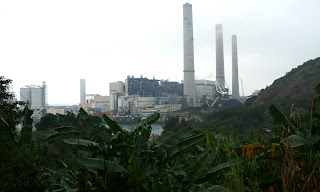
Wow! It's been over two months since I last posted anything here. Shocking.
I also notice that, despite the blog title, I have hardly yet talked about Lamma on these pages. Let’s try to rectify that with some thoughts about life here.
First, to get some stereotypes out of the way. Yes, there are some washed up old hippies here; and yes, there are an abundance of freelance journalists and full-time environmentalists here too. But the common perception of Lamma does a great disservice to the fascinating diversity of people here.
My favourite thing to do here is to take a quiet wander down the lesser-travelled paths, negotiating the stray dogs and their ever-present booby-traps, but negating the need to jump out of the way of the village vehicles. No cars on the island, you see, just what look like ‘estate’ quad bikes and, of course, the Bedford Rascal van that is our ambulance. God forbid a typical Westerner requires it; we’re too tall to lie down!
Leave Yung Shue Wan and its plethora of mouth-wateringly good Western and Chinese restaurants behind. Let the crowds of tourists head over the family trail past pristine semi-deserted beaches and on towards the famous fish restaurants of Sok Kwu Wan. And pass the returning commuters (lawyers; company directors; salesmen; and, yes, the odd kung-fu or yoga instructor, or part-time teacher) as they hit the bars of Main Street and pick up their vegetables from the grocery stores or market stalls. Before too long, you’ll see another side to Lamma. Subsistence fishing or farming villages abound, each one a fascinating slice of ‘the old Hong Kong.’ Here, mah-jong is played daily and long into the night, and life – to those of us accustomed to city dwelling – appears (forgive the cliché) hard but honest.
But, like much of rural Hong Kong, all is not well. The number of abandoned village houses and empty schools speaks volumes about a people that wish to move onwards and upwards. And good luck to them. As an expat, this exodus to urban areas seems a dreadful shame, but who am I to hope villagers remain forever so simply for their aesthetic appeal. I do hope, though, that Lamma will never lose sight of its inherent appeal as a place to get away from the vertiginous towers and relentless pace of life of Hong Kong or Kowloon.
So come visit Lamma, and see for yourself what draws such an assorted crowd here. Bring some food and use the bbq pits on the beach, or eat some of the freshest fish around – from the floating fish farms in Sok Kwu Wan directly to your table. Just don’t come on a sunny holiday weekend, when the roads are so full of pedestrians that gridlock ensues. If, that is, you haven’t been put off by the two-hour plus queue for a ferry.










